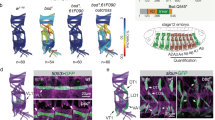Abstract
Scribble (scrib), discs large (dlg) and lethal giant larvae (lgl) encode proteins that regulate cell polarity and have been identified as neoplastic tumour suppressor genes in Drosophila melanogaster. Here, we have used the Drosophila model system to provide the first functional evidence that human Scribble (hScrib) can act as a tumour suppressor. We show that hScrib protein displays highly polarized localization in mammalian epithelial cells and colocalizes with mammalian Dlg, similar to D. melanogaster Scribble (DmScrib) distribution in Drosophila epithelium. Furthermore, hScrib can rescue the polarity and tumorous overgrowth defects of scrib mutant Drosophila. hScrib therefore can act as an effective tumour suppressor in vivo, regulating both apical–basal polarity and cellular proliferation in a manner similar to that of DmScrib in Drosophila. These data demonstrate that hScrib is a functional homologue of DmScrib and therefore predict an important role for hScrib in the suppression of mammalian tumorigenesis.
This is a preview of subscription content, access via your institution
Access options
Subscribe to this journal
Receive 50 print issues and online access
$259.00 per year
only $5.18 per issue
Buy this article
- Purchase on Springer Link
- Instant access to full article PDF
Prices may be subject to local taxes which are calculated during checkout



Similar content being viewed by others
References
Behrens J, Birchmeier W, Goodman SL and Imhof BA . (1985). J. Cell Biol., 101, 1307–1315.
Bilder D, Li M and Perrimon N . (2000). Science, 289, 113–116.
Bilder D and Perrimon N . (2000). Nature, 403, 676–680.
Bissell MJ and Radisky D . (2001). Nat. Rev. Cancer, 1, 46–54.
Boussioutas A, Li H, Liu J, Waring P, Lade S, Holloway AJ, Taupin D, Gorringe K, Haviv I, Desmond PV and Bowtell DD . (2003). Cancer Res., 63, 2569–2577.
Brand AH and Perrimon N . (1993). Development, 118, 401–415.
Gateff E . (1994). Int. J. Dev. Biol., 38, 565–590.
Huang JH, Rajkovic A, Szafranski P, Ochsner S, Richards J and Goode S . (2003). Gene Expression Patterns, 3, 3–11.
Humbert P, Russell S and Richardson H . (2003). Bioessays, 25, 542–553.
Ishidate T, Matsumine A, Toyoshima K and Akiyama T . (2000). Oncogene, 19, 365–372.
Lee T and Luo L . (1999). Neuron, 22, 451–461.
Liu LX, Liu ZH, Jiang HC, Qu X, Zhang WH, Wu LF, Zhu AL, Wang XQ and Wu M . (2002). World J. Gastroenterol., 8, 580–585.
Ludford-Menting MJ, Thomas SJ, Crimeen B, Harris LJ, Loveland BE, Bills M, Ellis S and Russell SM . (2002). J. Biol. Chem., 277, 4477–4484.
Makino K, Kuwahara H, Masuko N, Nishiyama Y, Morisaki T, Sasaki J, Nakao M, Kuwano A, Nakata M, Ushio Y and Saya H . (1997). Oncogene, 14, 2425–2433.
Mantovani F and Banks L . (2001). Oncogene, 20, 7874–7887.
Mathew D, Gramates LS, Packard M, Thomas U, Bilder D, Perrimon N, Gorczyca M and Budnik V . (2002). Curr. Biol., 12, 531–539.
Montcouquiol M, Rachel RA, Lanford PJ, Copeland NG, Jenkins NA and Kelley MW . (2003). Nature, 423, 173–177.
Murdoch JN, Henderson DJ, Doudney K, Gaston-Massuet C, Phillips HM, Paternotte C, Arkell R, Stanier P and Copp AJ . (2003). Hum. Mol. Genet., 12, 87–98.
Nakagawa S and Huibregtse JM . (2000). Mol. Cell. Biol., 20, 8244–8253.
Stevenson BR, Siliciano JD, Mooseker MS and Goodenough DA . (1986). J. Cell Biol., 103, 755–766.
Thiery JP . (2002). Nat. Rev. Cancer, 2, 442–454.
Thomas U, Phannavong B, Muller B, Garner CC and Gundelfinger ED . (1997). Mech. Dev., 62, 161–174.
Woodhouse E, Hersperger E and Shearn A . (1998). Dev. Genes Evol., 207, 542–550.
Woods DF and Bryant PJ . (1991). Cell, 66, 451–464.
Woods DF, Hough C, Peel D, Callaini G and Bryant PJ . (1996). J. Cell Biol., 134, 1469–1482.
Acknowledgements
We thank G Poortinga for discussions and for comments on the manuscript. We thank the Kazuza DNA Research Institute for the KIAA0147 cDNA clone, D Bilder for the scrib1 fly stock and J Treisman for the ey-FLP; GAL4,FRT82B,GAL80 stock. LED was supported by a Cancer Council Victoria Postgraduate Cancer Research Scholarship. JAT is a Principal Research Fellow of the National Health & Medical Research Council of Australia, SMR and HER are Wellcome Senior Research Fellows in Medical Science and POH is a Special Fellow of the Leukemia and Lymphoma Society of America.
Author information
Authors and Affiliations
Corresponding author
Rights and permissions
About this article
Cite this article
Dow, L., Brumby, A., Muratore, R. et al. hScrib is a functional homologue of the Drosophila tumour suppressor Scribble. Oncogene 22, 9225–9230 (2003). https://doi.org/10.1038/sj.onc.1207154
Received:
Revised:
Accepted:
Published:
Issue Date:
DOI: https://doi.org/10.1038/sj.onc.1207154
Keywords
This article is cited by
-
The Scribble family in cancer: twentieth anniversary
Oncogene (2020)
-
Phosphorylation-dependent interaction between tumor suppressors Dlg and Lgl
Cell Research (2014)
-
Regulation of asymmetric cell division and polarity by Scribble is not required for humoral immunity
Nature Communications (2013)
-
Epithelial cell polarity: a major gatekeeper against cancer?
Cell Death & Differentiation (2011)
-
Epithelial cell polarity and tumorigenesis: new perspectives for cancer detection and treatment
Acta Pharmacologica Sinica (2011)



